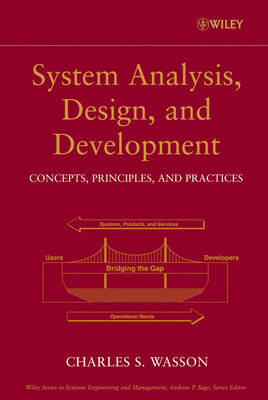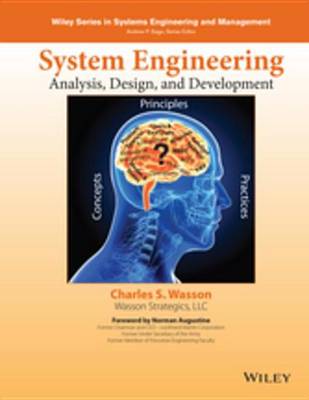Wiley Series in Systems Engineering and Management
2 primary works • 3 total works
Book 22
System Analysis, Design and Development – Concepts, Principles and Practices
by Charles S. Wasson
Published 13 December 2005
Written in a practical, easy to understand style, this text provides a step-by-step guide to System Analysis and Engineering by introducing concepts, principles, and practices via a progression of topical, lesson oriented chapters. Each chapter focuses on specific aspects of system analysis, design, and development, and includes definitions of key terms, examples, author's notes, key principles, and challenging exercises that teach readers to apply their knowledge to real world systems. Concepts and methodologies presented can be applied by organizations in business sectors such as transportation, construction, medical, financial, education, aerospace and defense, utilities, government, and others, regardless of size. An excellent undergraduate or graduate-level textbook in systems analysis and engineering, this book is written for both new and experienced professionals who acquire, design, develop, deploy, operate, or support systems, products, or services.
Book 22
* Written in a practical, easy to understand style, this text provides a step-by-step guide to System Analysis and Engineering by introducing concepts, principles, and practices via a progression of topical, lesson oriented chapters.* Each chapter focuses on specific aspects of system analysis, design, and development, and includes definitions of key terms, examples, author's notes, key principles, and challenging exercises that teach readers to apply their knowledge to real world systems.* Concepts and methodologies presented can be applied by organizations in business sectors such as transportation, construction, medical, financial, education, aerospace and defense, utilities, government, and others, regardless of size.* An excellent undergraduate or graduate-level textbook in systems analysis and engineering, this book is written for both new and experienced professionals who acquire, design, develop, deploy, operate, or support systems, products, or services.
System Engineering Analysis, Design, and Development
by Charles S. Wasson
Published 16 November 2015
Praise for the first edition: This excellent text will be useful to every system engineer (SE) regardless of the domain. It covers ALL relevant SE material and does so in a very clear, methodical fashion. The breadth and depth of the author's presentation of SE principles and practices is outstanding. Philip Allen This textbook presents a comprehensive, step-by-step guide to System Engineering analysis, design, and development via an integrated set of concepts, principles, practices, and methodologies. The methods presented in this text apply to any type of human system -- small, medium, and large organizational systems and system development projects delivering engineered systems or services across multiple business sectors such as medical, transportation, financial, educational, governmental, aerospace and defense, utilities, political, and charity, among others.
Provides a common focal point for bridging the gap between and unifying System Users, System Acquirers, multi-discipline System Engineering, and Project, Functional, and Executive Management education, knowledge, and decision-making for developing systems, products, or services Each chapter provides definitions of key terms, guiding principles, examples, author s notes, real-world examples, and exercises, which highlight and reinforce key SE&D concepts and practices Addresses concepts employed in Model-Based Systems Engineering (MBSE), Model-Driven Design (MDD), Unified Modeling Language (UML TM ) / Systems Modeling Language (SysML TM ), and Agile/Spiral/V-Model Development such as user needs, stories, and use cases analysis; specification development; system architecture development; User-Centric System Design (UCSD); interface definition & control; system integration & test; and Verification & Validation (V&V) Highlights/introduces a new 21st Century Systems Engineering & Development (SE&D) paradigm that is easy to understand and implement.
Provides practices that are critical staging points for technical decision making such as Technical Strategy Development; Life Cycle requirements; Phases, Modes, & States; SE Process; Requirements Derivation; System Architecture Development, User-Centric System Design (UCSD); Engineering Standards, Coordinate Systems, and Conventions; et al. Thoroughly illustrated, with end-of-chapter exercises and numerous case studies and examples, Systems Engineering Analysis, Design, and Development, Second Edition is a primary textbook for multi-discipline, engineering, system analysis, and project management undergraduate/graduate level students and a valuable reference for professionals.
Provides a common focal point for bridging the gap between and unifying System Users, System Acquirers, multi-discipline System Engineering, and Project, Functional, and Executive Management education, knowledge, and decision-making for developing systems, products, or services Each chapter provides definitions of key terms, guiding principles, examples, author s notes, real-world examples, and exercises, which highlight and reinforce key SE&D concepts and practices Addresses concepts employed in Model-Based Systems Engineering (MBSE), Model-Driven Design (MDD), Unified Modeling Language (UML TM ) / Systems Modeling Language (SysML TM ), and Agile/Spiral/V-Model Development such as user needs, stories, and use cases analysis; specification development; system architecture development; User-Centric System Design (UCSD); interface definition & control; system integration & test; and Verification & Validation (V&V) Highlights/introduces a new 21st Century Systems Engineering & Development (SE&D) paradigm that is easy to understand and implement.
Provides practices that are critical staging points for technical decision making such as Technical Strategy Development; Life Cycle requirements; Phases, Modes, & States; SE Process; Requirements Derivation; System Architecture Development, User-Centric System Design (UCSD); Engineering Standards, Coordinate Systems, and Conventions; et al. Thoroughly illustrated, with end-of-chapter exercises and numerous case studies and examples, Systems Engineering Analysis, Design, and Development, Second Edition is a primary textbook for multi-discipline, engineering, system analysis, and project management undergraduate/graduate level students and a valuable reference for professionals.


